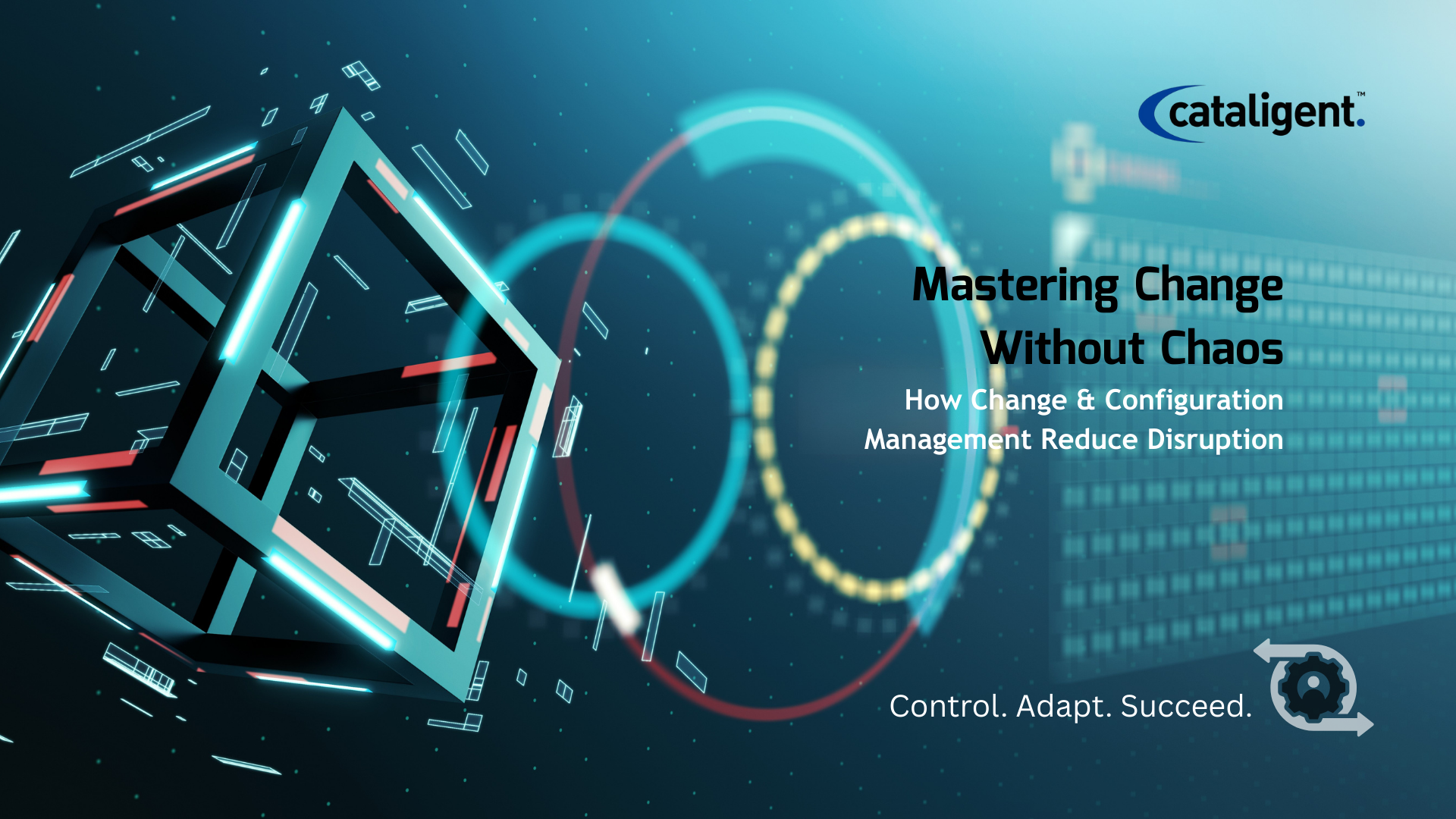What is Change Management & Configuration Management?
Change Management is a structured approach to implementing updates, upgrades, and modifications in IT systems, ensuring that these changes occur smoothly and with minimal disruption. Configuration Management involves maintaining accurate and comprehensive records of all IT assets, their configurations, and interdependencies. Together, these practices provide visibility into the IT environment, enabling proactive decision-making, risk reduction, and alignment with business objectives.
Cataligent helps organizations establish and refine change and configuration management frameworks that minimize downtime, prevent errors, and facilitate seamless IT transitions.
Why Change Management & Configuration Management are Critical
Effective change and configuration management is essential for business continuity, operational stability, and cost efficiency:
- Minimizing Operational Disruption: Structured processes ensure that updates, patches, and system modifications are implemented without interrupting essential business operations, avoiding productivity loss and revenue impact.
- Risk Reduction: Conducting impact analysis and understanding configuration dependencies reduces the likelihood of system failures, service outages, or security vulnerabilities.
- Improved Resource Planning: Knowing which systems and dependencies are affected by changes allows organizations to allocate personnel, time, and financial resources more effectively, avoiding waste.
- Enhanced Communication and Accountability: Clearly defined approval workflows, roles, and responsibilities ensure all stakeholders understand their duties, improving coordination and reducing errors.
- Regulatory Compliance and Audit Readiness: Maintaining detailed records of changes and configurations supports compliance with industry regulations and simplifies audit processes.
- Operational Efficiency and Predictability: Standardized processes reduce the risk of trial-and-error implementations, enabling smoother and more predictable change rollouts.
Without effective change and configuration management, organizations risk extended downtime, repeated errors, operational inefficiencies, and increased costs from corrective actions.
How Change Management & Configuration Management Shape Cost Saving and Efficiency
Implementing these practices provides tangible operational and financial benefits:
- Structured Change Approval:
Cataligent helps organizations establish robust approval processes where each proposed change is evaluated for risk, impact, and necessity before implementation. This proactive approach prevents costly mistakes, unnecessary downtime, and service interruptions. - Configuration Tracking and Documentation:
Maintaining a comprehensive Configuration Management Database (CMDB) allows IT teams to track assets, relationships, and system dependencies. Cataligent ensures accurate documentation, reducing troubleshooting time, preventing misconfigurations, and improving decision-making for future changes. - Impact Analysis and Risk Assessment:
Cataligent guides organizations in assessing potential impacts of each change, identifying possible points of failure, and developing contingency plans. This reduces the likelihood of negative consequences and supports informed decision-making. - Automated Change Scheduling:
Scheduling changes during off-peak periods, combined with automated notifications and reminders, minimizes business disruption and ensures smooth execution. Cataligent implements automated tools that streamline scheduling, reduce human error, and improve coordination. - Monitoring and Post-Implementation Review:
After changes are implemented, Cataligent supports organizations in tracking outcomes, comparing actual results with expected outcomes, and identifying areas for process improvement. This continuous feedback loop reduces the risk of repeated mistakes and strengthens future change management practices. - Integration with ITSM and Business Processes:
Cataligent aligns change management processes with broader ITSM workflows, including incident, problem, and service request management. This ensures that IT operations are coherent, resources are optimized, and changes support strategic business objectives.
How Cataligent Can Help
Cataligent provides comprehensive support for change and configuration management:
- Change Management Framework Implementation: Develops clear approval, scheduling, and communication processes.
- Configuration Management Database (CMDB): Creates and maintains an accurate repository of assets, relationships, and configurations for effective impact analysis.
- Impact Assessment Tools: Provides analytics to evaluate change risks and reduce potential disruptions.
- Automated Scheduling and Notifications: Streamlines implementation processes, minimizing manual errors and delays.
- Post-Change Review and Reporting: Monitors results, identifies lessons learned, and refines processes for continuous improvement.
- Integration with IT Operations: Aligns change management with incident, problem, and service request management for holistic ITSM performance.
Embedded Value for Organizations
- Reduced Downtime and Disruption: Ensures seamless implementation of updates and modifications, maintaining productivity.
- Cost Efficiency: Prevents errors, rollbacks, and repeated troubleshooting, saving time and resources.
- Enhanced Risk Management: Evaluates and mitigates risks proactively.
- Regulatory Compliance: Maintains accurate records and documented procedures for audits and compliance requirements.
- Operational Predictability: Standardized processes improve coordination, transparency, and reliability.
- Data-Driven Improvements: Post-implementation insights enable ongoing refinement of change strategies.
- Strategic Alignment: Ensures IT changes support business objectives while optimizing resources and minimizing disruptions.
Effective change and configuration management allow organizations to implement IT updates and modifications seamlessly, reducing risks, operational disruptions, and costs. Cataligent ensures structured workflows, accurate configuration tracking, and continuous process improvement, transforming ITSM into a strategic driver of reliable, efficient, and cost-effective IT operations.

